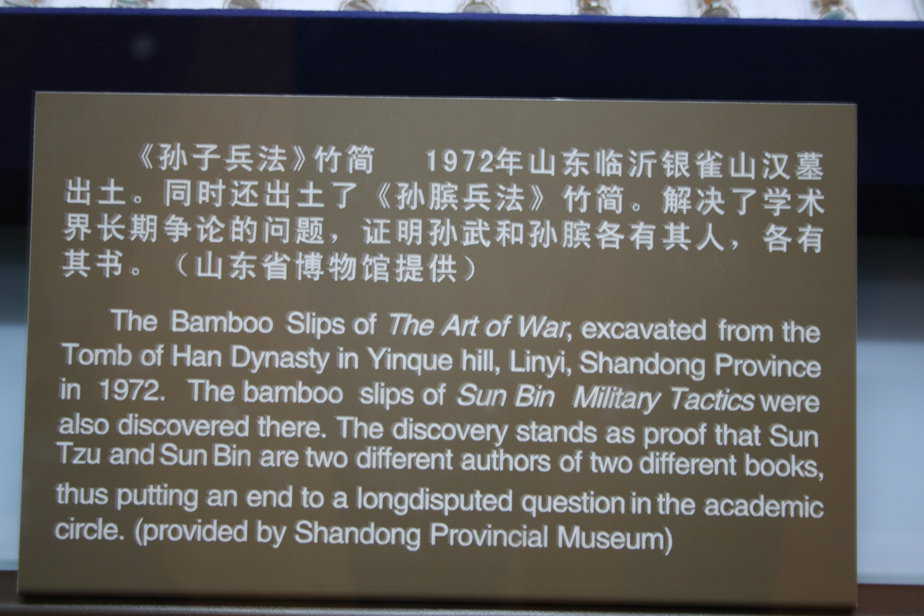
Sun Tzu portrait. Photo by Unknown author. Wikimedia Commons.
Top 10 Interesting Facts about Sun Tzu
Sun Tzu was a Chinese military strategist and philosopher in ancient China. He is known for writing the ‘Art of War.’ It is probably the most influential and widely read book on war strategy today.
He is known for his philosophy of winning a war without openly attacking. This is depicted in one of his maxims; ‘The supreme art of war is to subdue the enemy without fighting.’
According to him, the war best won is that whose victory is attained without fighting. Centuries later, Sun Tzu’s philosophy is relevant across numerous fields such as war, the corporate world, leadership management, and human psychology. Here are the top 10 interesting facts about Sun Tzu.
1. Sun Tzu’s existence is contested

Military Museum: Ancient Weapons special exhibit. Bamboo slips of Art of War. Photo by Gary Todd. Wikimedia Commons.
The name Sun Tzu does not appear in major historical records written during the period he allegedly lived. Some historians therefore deem him a fictional character.
Others have regarded him as identical to his supposed descendant, Sun Bin, who also wrote a military treatise titled ‘Art of War.’ This claim was dismissed upon the discovery of two manuscripts in 1972, on the Art of War. One was held to be Sun Bin’s, and the other, Sun Tzu’s.
However, Sima Qian, a historian, places Sun Tzu’s existence during the Summer and Autumn Period in Chinese history. It was a period of wars between the 7 major states of ancient China. His lifetime is dated to 544-496 BC.
Another record that supports Sun Tzu’s existence is the ‘Spring and Autumn Annals of Wu’. It records him as a military strategist to King He-Lu of Wu.
2. Sun Tzu was born in Qi
According to the ‘Records of the Grand Historian, he was born in the state of Qi. The historical record is an account by Sima Qian, a historian of the Han Dynasty.
This fact is also contested. The Spring and Autumn Annals of Wu, another historical record, accounts that Sun Tzu was born in the state of Wu. It is where he later serves King He-Lu of Wu as a military strategist.
3. His birth name is ‘Sun Wu.’
Chinese culture employs honorifics, which are titles or words used in respect of revered people. Sun was his family name. Tzu means ‘master’. He is popularly known as Sun Tzu meaning ‘Master Sun’. He was however born, Sun Wu.
4. He was a military strategist to the King of Wu
King He-Lu of Wu became the king after the assassination of King Liao. Sun Tzu was instrumental in attaining victory for the king in his battles against the rival state of Chu.
They managed to capture Ying, the capital of Chu, in the Battle of Bajo. It was one of the major battles waged between the two states.
Sun Tzu studied military science. He won many battles for the King of Wu and later used his experience to write the Art of War.
5. Sun Tzu had to train 180 concubines into an army as a test of his skill

Records of the Grand Historian. Photo by Unknown author. Wikimedia Commons.
This is recorded in the Records of the Grand Historian. Before King He-Lu of Wu could hire him, Sun Tzu had to pass this test.
He divided them into two groups and appointed one concubine as commander of each. Sima Qian narrates that when Sun Tzu first directed them to turn right, they chuckled.
He repeated the command and they giggled again. At this point, he explained that if the soldiers understood a command but disobeyed, they were liable.
He then ordered the execution of the commanders. The concubines took the training seriously after that.
6. The unexpected victory at the Battle of Bajo is accredited to Sun Tzu
At around 506 BC, the states of Wu and Chu were at war. Wu’s army was greatly outnumbered. The King ordered retreat since the army could not effectively attack in such few numbers.
However, the King’s brother, Fugai, defied the King’s orders and led the army of Wu in attacking Chu’s brigade. Sun Tzu advised Fugai to use spies and study the enemy, which he did.
They realized that Chu’s army disliked their commander. It was unlikely that they would be willing to die for their commander. Fugai was inspired to attack. Wu won the war despite their fewer numbers.
The strategy of using spies is typical of Sun Tzu’s thinking. It is reflected in one of his maxims, ‘Know your enemy, know thyself and you can fight a thousand battles without disaster.’
7. He wrote the ‘Art of War’

Sun Tzu’s, The Art of War’. Photo by Kallemax. Wikimedia Commons.
It has been termed the ‘most prestigious and influential book of strategy today. It is a military treatise, detailing strategy for war.
Having been in existence for over 2,000 years, generations of leaders, war generals, and politicians have benefitted from Sun Tzu’s ideas. It is used as instructional material at the US Military Academy at West Point.
The art of deception, as outlined in the book, was widely used by the KGB. Military leaders have commented on the relevance of Sun Tzu’s ideas in strategy. It has been translated into other languages, including English.
It has 13 chapters, each focusing on a different set of warfare skills. Sun Tzu is emphatic about using intelligence over force to conquer an enemy.
The use of spies, deception, and utilizing one’s weaknesses are typical features of Sun Tzu’s philosophy as captured in the Art of War.
8. Several commentaries on the Art of War have been written

Eleven Commentaries to the Art of War by Sunzi (Sun Tzu). The commentaries are by Cao Cao (155–220) of the Three Kingdoms period; Meng of the Liang dynasty (502–57); Li Quan, Du Mei, Chen Hao, and Jia Lin, four scholars of the Tang dynasty; Mei Yaochen, Wang Xi, He Yanxi, and Zhang Yu of the Song dynasty; and the Tang historian Du You. Photo by Unknown author. Wikimedia Commons.
The earliest of this is probably by Cao Cao, a Chinese warlord in the 3rd century AD. He changed parts of the original text, editing and removing certain passages. The extent to which he did this is unclear.
The commentaries clarify the text’s meaning, offering different but related explanations from the different authors.
9. Chairman Mao drew inspiration from Sun Tzu’s Art of War

photo of Mao Zedong sitting, published in “Quotations from Chairman Mao Tse-Tung”. Photo by The People’s Republic of China Printing Office . Wikimedia Commons.
Chairman Mao, formally known as Mao Zedong, was a Chinese communist leader. He was a great fan of the Art of War treatise.
From around 1927 to 1947, the Chinese Civil War occurred. This was a result of differences between the Chinese Communist Party, led by Mao, and the Kuomintang (KMT), led by Chiang Kai-Shek.
Mao attributed his success in the conflict to Sun Tzu’s Art of War.
10. Sun Tzu and the Art of War are referenced in films and books
These include the movie Wall Street, which has several references to the two.
In ‘Die Another Day’, the Art of War is referred to as the shared spiritual guide by Colonel Moon and his father. In Star Trek: The Next Generation, William Riker quotes ‘The Art of War’ to Captain Picard.
Robert Greene uses philosophy from the Art of War in his book, ‘The 48 Laws of Power.
Planning a trip to Paris ? Get ready !
These are Amazon’s best-selling travel products that you may need for coming to Paris.
Bookstore
- The best travel book : Rick Steves – Paris 2023 – Learn more here
- Fodor’s Paris 2024 – Learn more here
Travel Gear
- Venture Pal Lightweight Backpack – Learn more here
- Samsonite Winfield 2 28″ Luggage – Learn more here
- Swig Savvy’s Stainless Steel Insulated Water Bottle – Learn more here
Check Amazon’s best-seller list for the most popular travel accessories. We sometimes read this list just to find out what new travel products people are buying.









